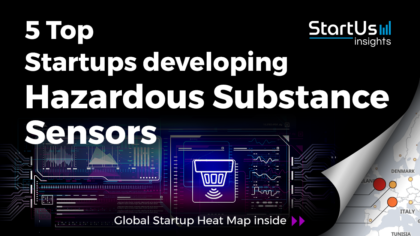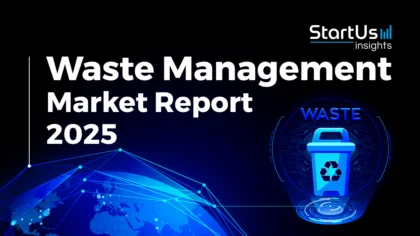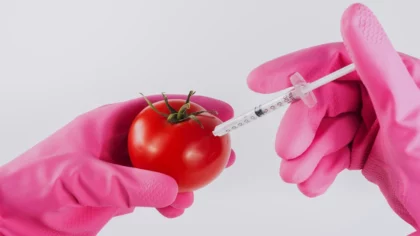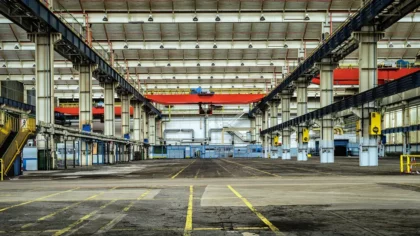Accelerate Productivity in 2025
Reignite Growth Despite the Global Slowdown
Staying ahead of the technology curve means strengthening your competitive advantage. That is why we give you data-driven innovation insights. This time, you get to discover 5 hand-picked startups developing hazardous substance sensors.
Global Startup Heat Map highlights 5 Top Startups developing Hazardous Substance Sensors out of 181
The insights of this data-driven analysis are derived from the Big Data & Artificial Intelligence-powered StartUs Insights Discovery Platform, covering 2.093.000+ startups & scaleups globally. The platform gives you an exhaustive overview of emerging technologies & relevant startups within a specific field in just a few clicks.
The Global Startup Heat Map below reveals the distribution of the 181 exemplary startups & scaleups we analyzed for this research. Further, it highlights 5 sensor startups that we hand-picked based on criteria such as founding year, location, funding raised, and more. You get to explore the solutions of these 5 startups & scaleups in this report. For insights on the other 176 hazardous substance sensor solutions, get in touch.
Oxford Molecular Biosensors develops Whole-Cell Biosensors
The presence of hazardous substances has a negative impact on the environment and human health. There is implicit difficulty in modeling artificial systems that can sense hazardous substances. For example, chemical kits that detect arsenic in water, are expensive and do not allow for in-situ testing. To facilitate detection of hazardous substances, startups develop biosensors that detect different hazardous substances in water and air through biochemical reactions.
British startup Oxford Molecular Biosensors utilizes biosensors to inspect water toxicity. The biosensors use environmental bacteria for both saline and freshwater application. The general and genotoxicity biosensors determine the combined toxic effect of substances within a sample. The latter of the two also estimates the specific ability of the components to cause gene damage. These biosensors find varied usage in wastewater treatment plants, water bodies, road run-offs, research and development, and many more.
Oizom enables Industrial Hazard Detection
The development of different technologies like protective masks, safety goggles, and hard hats ensures healthy working conditions for workers. However, industrial workplaces contain many hazardous particles floating in the air, posing a threat to worker safety. Sensors monitor work conditions, including ambient air toxicity levels inside the workplace. This enables the detection of harmful gases such as sulfur oxides (SOx), nitrous oxides (NOx), carbon monoxide (CO), ozone (O3), and many more.
Indian startup Oizom creates sensor solutions for industries. The AQBot series includes single parameter gas monitors that provide real-time data while withstanding harsh industrial conditions. It detects air quality, SOx, NOx, CO, and O3 levels. The solution enables threshold-based triggers that alert the concerned managers with visual and sonic alarms. Accurate data monitoring helps timely actions to lower air pollution.
Pollen Sense offers Household Mold Detection Sensors
Mold causes adverse health conditions across households. Since individuals rarely wear protective gear indoors, mold poses a threat to pulmonological and overall respiratory health. Thus, startups are working on solutions that address this problem. To achieve this, startups develop sensors that detect mold in households, alerting members when any such conditions exist.
US-based startup Pollen Sense develops mold detection sensors. The automated airborne particle sensors use small microscopes to detect airborne mold and display the results immediately on mobile phones through an app. The sensors are small in size and capture airborne particles like mold, dust, and pollen and image them through a microscope. The sensors also find usage in other industries such as agriculture, smart city, hospitals, and more.
BIOsens delivers Hazardous Food Substance Sensors
Hazardous food substances pose a health risk to consumers as well as impact the entire supply chain. Besides this, producers also incur high costs owing to call-backs and refunds. Thus, it is crucial to monitor hazardous substances in food products to ensure food safety. This is why FoodTech startups develop sensors to detect the presence of any elements that would make the food unfit for consumption.
Ukrainian startup BIOsens builds hazardous food substance sensors. Its solution is a device that accepts ground food substances to detect spoilage or foreign growth. Aggregation of this data in a warehouse enables analysis of the food. It notifies mold growth in crops, controls the safety of livestock feed, and monitors the condition of stored grains.
Blue Sources provides Monitoring-as-a-Service (MaaS)
Sensing and monitoring at scale is not a feasible option for small businesses. The capital and operational expenditure of the related technologies makes them unsuitable for projects and businesses operating on a smaller scale. However, these technologies are a necessity to maintain safe working conditions. Startups solve this issue by providing monitoring-as-a-service (MaaS), providing sensor technology and technical expertise to businesses that require these services, enabling compliance with regulations at marginal costs.
Blue Sources is a US-based startup that provides MaaS. The startup’s technology, BG-n, continuously monitors for the presence of toxic chemicals in water streams. It monitors Bluegill fish for water conditions with the help of the Ecotox database. The database lists thousands of studies detailing Bluegill’s response to various toxic chemicals. With this data, the device accurately detects contaminants in water. The setup includes a water quality sonde, fish monitoring chambers, and a monitoring device.
Discover more startups
Startups such as the examples highlighted in this report focus on biosensors, nanosensors, and quality management. While all of these technologies play a major role in advancing the industry, they only represent the tip of the iceberg. To explore more sensor technologies, simply get in touch to let us look into your areas of interest. For a more general overview, you can download our free Industry Innovation Reports to save your time and improve strategic decision-making.



![Explore the 10 Emerging Smart City Trends [2025-2026]](https://www.startus-insights.com/wp-content/uploads/2025/06/Smart-City-Trends-SharedImg-StartUs-Insights-noresize-420x236.webp)




